
Nevsky Prospect is a main street located in the federal city of St. Petersburg in Russia. Its name comes from the Alexander Nevsky Lavra, the monastery which stands at the eastern end of the street, and which commemorates the Russian hero Prince Saint Alexander Nevsky (1221–1263). Following his founding of Saint Petersburg in 1703, Tsar Peter I planned the course of the street as the beginning of the road to Novgorod and Moscow. The avenue runs from the Admiralty in the west to the Moscow Railway Station and, after veering slightly southwards at Vosstaniya Square, to the Alexander Nevsky Lavra.

Kolomenskaya is an underground metro station on the Zamoskvoretskaya Line of the Moscow Metro in Moscow, Russia. It was named after the nearby Kolomenskoye museum-park. The station is situated at the intersection of Andropov avenue, Nagatinskaya and Sudostroitelnaya streets
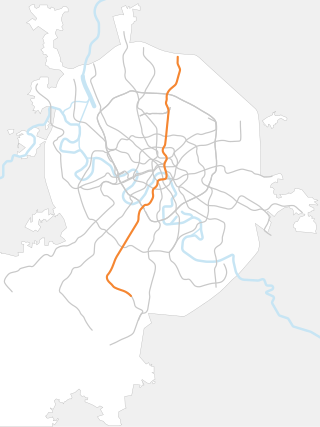
The Kaluzhsko-Rizhskaya line is a line of the Moscow Metro, that originally existed as two separate radial lines, Rizhskaya and Kaluzhskaya opened in 1958 and 1962, respectively. Only in 1971 were they united into a single line as the central section connecting the stations Oktyabrskaya to Prospekt Mira was completed. It was also the first line in Moscow to have a cross-platform transfer. The Rizhsky radius is roughly aligned with a northern avenue Prospekt Mira, while the Kaluzhskiy radius generally follows a southwestern street Profsoyuznaya Ulitsa. Presently, the Kaluzhsko-Rizhskaya line is the third busiest in the system with a passenger traffic rate of 1.015 million per day. It has a bi-directional length of 37.8 kilometres (23.5 mi), and a travel time of 56 minutes, typically it is coloured orange on Metro maps and numbered 6.
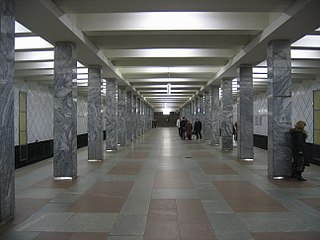
Profsoyuznaya is a station on the Kaluzhsko-Rizhskaya Line of the Moscow Metro. Opened in 1962.
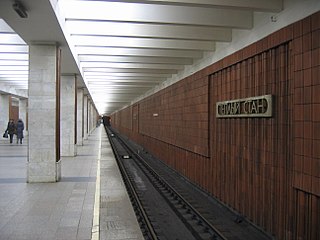
Tyoply Stan is a station near the southern end of the Moscow Metro's Kaluzhsko-Rizhskaya Line.
The British International School of Moscow (BIS) is a private international school in Moscow, Russia. The school was founded in 1994 to meet the needs of expatriate or Russian parents who wished for their children to be taught in English using the English National Curriculum, as adapted to meet the needs of international pupils.

Volgogradsky Prospekt is a Moscow Metro station in the Nizhegorodsky District, South-Eastern Administrative Okrug, Moscow. It is on the Tagansko-Krasnopresnenskaya Line, between Proletarskaya and Kuzminki stations. Volgogradsky Prospekt was opened on 31 December 1966 as part of the Zhadovsky radius and is named after the nearby Avenue that leads on from the centre of Moscow into an intercity highway all the way to the southwest of Russia, although not directly to Volgograd. The station was built to a slight modification of the standard 1960s pillar-trispan decoration showing the first signs of innovative design, as architects V. Polikarpova and A. Marova did. The platform is narrowed. The white ceramic tiles on the walls are arranged on 45 degrees to the platform and are decorated with metallic artworks out of anodized aluminium depicting the Battle of Stalingrad. The pillars are faced with white marble whilst the floor with grey granite. The station has two underground vestibules with glazed concrete pavilions which allow passengers access to the Talalikhin and Novostapovskaya streets as well as directly to the AZLK automobile plant..

Tekstilshchiki is a Moscow Metro station in the Tekstilshchiki District, South-Eastern Administrative Okrug, Moscow. It is on Tagansko–Krasnopresnenskaya line, between Volgogradsky Prospekt and Kuzminki stations. Tekstilschiki was opened on 31 December 1966 as a part of the Zhdanovsky radius. The station is situated next to Tekstilshchiki railway station at the intersection of Volgogradsky avenue and Lyublinskaya street. A transfer to Tekstilshchiki is planned.

Ryazanskiy Prospekt is a station on Moscow Metro's Tagansko-Krasnopresnenskaya Line. Opened on 31 December 1966 as part of the Zhdanovsky radius, the station is situated where the line snakes northward and instead of following the Volgogradsky Avenue begins to follow the Ryazansky Avenue which runs several kilometres parallel to it on the north, another avenue and the original road to the city of Ryazan. Like all of the shallow-level stations built at the time, the design is a typical column tri-span, however like Volgogradsky Prospekt the platform has been narrowed. The composition of the station adopted the traditional Ryazan cloth theme to the wall decoration where the white tiles are distinctively articulated at the top with red patterns. Also prominent is the large black level the pillars are faced with grey-indigo marble and the floor is laid with grey and pink granite. Unusually the station has two surface vestibules, each on both sides of the Ryazanskoye Avenue as well as access to the Akademika Skryabina street. In March 2002 the station had a modest passenger traffic of 70,410.
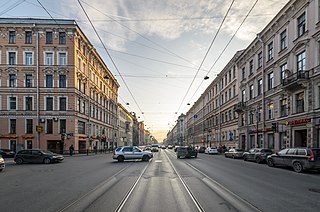

Leningradsky Prospekt, or Leningrad Avenue, is a major arterial avenue in Moscow, Russia. It continues the path of Tverskaya Street and 1st Tverskaya-Yamskaya Street north-west from Belorussky Rail Terminal, and changes the name once again to Leningrad Highway past the Sokol metro station. The Highway continues its way to Saint Petersburg via Tver.
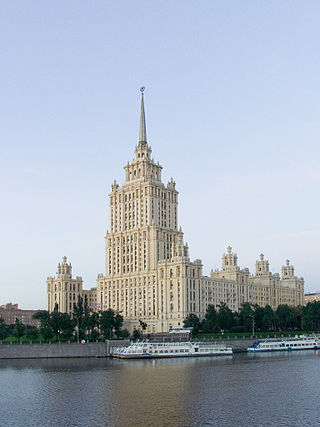
Kutuzovsky Prospekt is a major radial avenue in Moscow, Russia, named after Mikhail Illarionovich Kutuzov, leader of the Russian field army during the French invasion of Russia of 1812. The prospekt continues a westward path of Vozdvizhenka Street and New Arbat Street from Novoarbatsky Bridge over the Moskva River to the junction with Rublyovskoye Shosse; past this point, the route changes its name to Mozhaiskoye Shosse.
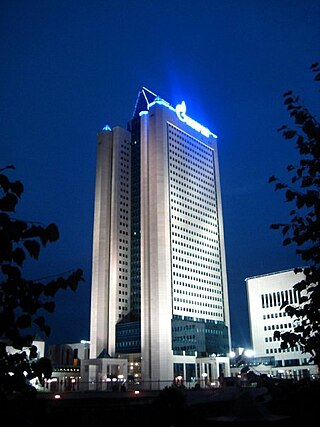
Cheryomushki District, formerly Brezhnevsky District, is a district of South-Western Administrative Okrug of the federal city of Moscow, Russia. Population: 102,619 (2010 Census); 89,264 (2002 Census).

Leninsky Avenue is a major avenue in Moscow, Russia, that runs in the south-western direction between Kaluzhskaya Square in the central part of the city through Gagarin Square to the Moscow Ring Road. It is a part of the M3 highway which continues from Moscow to Kaluga and Bryansk to the border with Ukraine, and used to provide connections with Kyiv and Odesa. It is also a part of the European route E101 connecting Moscow and Kyiv.

Nakhimovsky Prospekt is a station of Serpukhovsko-Timiryazevskaya Line of Moscow metro between Nagornaya and Sevastopolskaya. It was designed by V. S. Volovich, L. N. Popov, V. I. Klokov, and G. S. Mun.
Nakhimovsky (masculine), Nakhimovskaya (feminine), or Nakhimovskoye (neuter) may refer to:

Lomonosovsky Prospekt is an avenue in Moscow, Russia. It runs from Vavilova Street in the east to Mosfilmovskaya Street in the west.

Nina Aleksandrovna Aleshina was a Russian architect and head of the design department Metrogiprotrans for the Moscow Metro for a decade. Nineteen stations of the subway system were projects she participated in or led. She was honored with many awards during her career, including the designation in 1985 of Honored Architect of the Russian Soviet Federative Socialist Republic

Ploschad Muzhestva is an open public square, shaped as a roundabout, in the north-east of Saint Petersburg, Russia. Its name and decoration commemorate the fortitude city dwellers demonstrated during the nearly 900-day-long 1941–44 Nazi Germany Siege of Leningrad as the square opens the way to the biggest burial place of the siege victims Piskaryovskoye Memorial Cemetery.


















